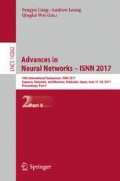Abstract
With the increasing incidence of epilepsy, we need to detect the epilepsy with high efficiency to avoid the disease attack. In this paper, we proposed two novel feature extraction methods for automatic epileptic seizure detection with high performance based on the statistic properties of complex network. One is the degree centrality combined with the linear features as the features to classify the epileptic EEG signal. Firstly, we transformed the time series into complex network by using horizontal visibility graph (HVG). Then we extracted the degree centrality of the complex network combined with the fluctuation index and variation coefficient as the three-dimensional features and the classification accuracy is up to 95.98%. To enhance the difference of the degree centrality feature, we put the other new feature. That is the improved degree centrality and chose the improved degree centrality as the single feature to classify the signal. Experimental results showed that the classification accuracy of this single feature is 96.50%.
Access this chapter
Tax calculation will be finalised at checkout
Purchases are for personal use only
References
Jing, H., Takigawa, M.: Topographic analysis of dimension estimates of EEG and filtered rhythms in epileptic patients with complex partial seizures. Biol. Cybern. 83(5), 391–397 (2000)
Osowski, S., Swiderski, B., Cichocki, A., Rysz, A.: Epileptic seizure characterization by Lyapunov exponent of EEG signal. COMPEL: Int J. Comput. Math. Electr. Electron. Eng. 26(5), 1276–1287 (2007)
Nurujjaman, M., Ramesh, N., Iyengar, A.N.S.: Comparative study of nonlinear properties of EEG signals of normal persons and epileptic patients. Nonlin. Biomed. Phys. 3(1), 6 (2009)
Kannathal, N., Lim, C.M., Acharya, U.R., Sadasivan, P.K.: Entropies for detection of epilepsy in EEG. Comput. Methods Programs Biomed. 80(3), 187–194 (2005)
Song, Y., Crowcroft, J., Zhang, J.: Automatic epileptic seizure detection in EEGs based on optimized sample entropy and extreme learning machine. J. Neurosci. Methods 210, 132–146 (2012)
Lake, D.E., Richman, J.S., Griffin, M.P., Moorman, J.R.: Sample entropy analysis of neonatal heart rate variability. Am. J. Physiol.-Regul. Integr. Comp. Physiol. 283, 789–797 (2002)
Zhang, J., Sun, J., Luo, X., Zhang, K., Nakamurad, T., Michael, S.: Characterizing pseudoperiodic time series through the complex network approach. Phys. D 237, 2856–2865 (2008)
Zhang, J., Small, M.: Complex network from Pseudoperiodic time series: topology versus dynamics. Phys. Rev. Lett. 96, 238701 (2006)
Lacasa, L., Luque, B., Ballesteros, F., Luque, J., Nuno, J.C.: From time series to complex networks: the visibility graph. Proc. Natl. Acad. Sci. U.S.A. 105(13), 4972–4975 (2008)
Yang, Y., Wang, J., Yang, H., Mang, J.: Visibility graph approach to exchange rate series. Phys. A: Stat. Mech. Appl. 388, 4431–4437 (2009)
Ni, X.H., Jiang, Z.Q., Zhou, W.X.: Degree distributions of the visibility graphs mapped from fractional Brownian motions and multifractal random walks. Phys. Lett. A 373, 3822–3826 (2009)
Lacasa, L., Luque, B., Luque, J., Nuño, J.C.: The visibility graph: a new method for estimating the Hurst exponent of fractional Brownian motion. EPL 86, 30001 (2009)
Luque, B., Lacasa, L., Ballesteros, F., Liuque, J.: Horizontal visibility graphs: exact results for random time series. Phys. Rev. E 80, 046103 (2009)
Moguerza, J., Muñoz, A.: Support vector machines with applications. Stat. Sci. 21, 322–336 (2006)
Cristianini, N., Shawe-Taylor, J.: An Introduction to Support Vector Machines and Other Kernel-Based Learning Methods. Cambridge University Press, London (2000)
Cai, D.-M., Zhou, W.-D., Li, S.-F., Wang, J.-W., Jia, G.-J., Liu, X.-W.: Classification of epileptic EEG based on detrended fluctuation analysis and support vector machine. Acta Biophys. Sinica 27, 175–182 (2011)
Li, S., Zhou, W., Yuan, Q., Geng, S.: Dongmei Cai.: feature extraction and recognition of ictal EEG using EMD and SVM. Comput. Biol. Med. 43, 807–816 (2013)
Acknowledgments
This work was supported by the National Natural Science Foundation of China (Grant Nos. 61671220, 61640218, 61201428), the Shandong Distinguished Middle-aged and Young Scientist Encourage and Reward Foundation, China (Grant No. ZR2016FB14), the Project of Shandong Province Higher Educational Science and Technology Program, China (Grant No. J16LN07), the Shandong Province Key Research and Development Program, China (Grant No. 2016GGX101022).
Author information
Authors and Affiliations
Corresponding author
Editor information
Editors and Affiliations
Rights and permissions
Copyright information
© 2017 Springer International Publishing AG
About this paper
Cite this paper
Liu, H., Meng, Q., Wei, Y., Zhang, Q., Liu, M., Zhou, J. (2017). A New Epileptic Seizure Detection Method Based on Degree Centrality and Linear Features. In: Cong, F., Leung, A., Wei, Q. (eds) Advances in Neural Networks - ISNN 2017. ISNN 2017. Lecture Notes in Computer Science(), vol 10262. Springer, Cham. https://doi.org/10.1007/978-3-319-59081-3_51
Download citation
DOI: https://doi.org/10.1007/978-3-319-59081-3_51
Published:
Publisher Name: Springer, Cham
Print ISBN: 978-3-319-59080-6
Online ISBN: 978-3-319-59081-3
eBook Packages: Computer ScienceComputer Science (R0)

